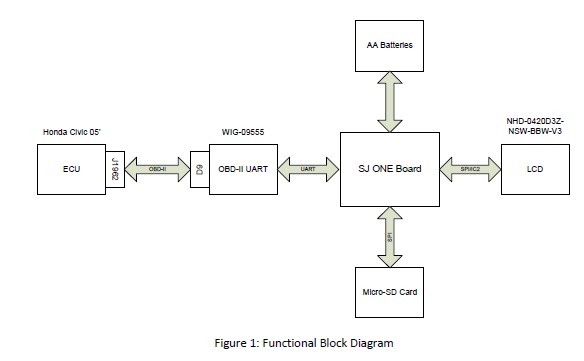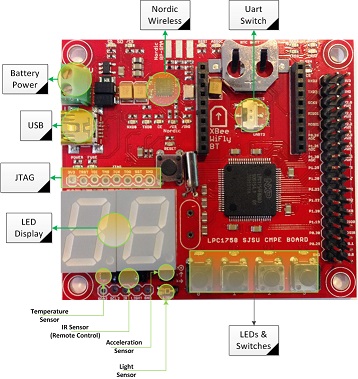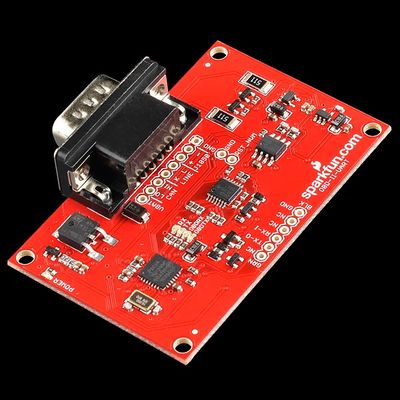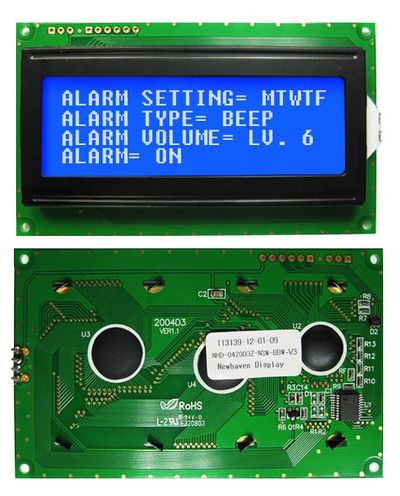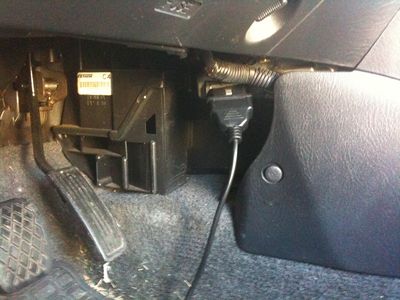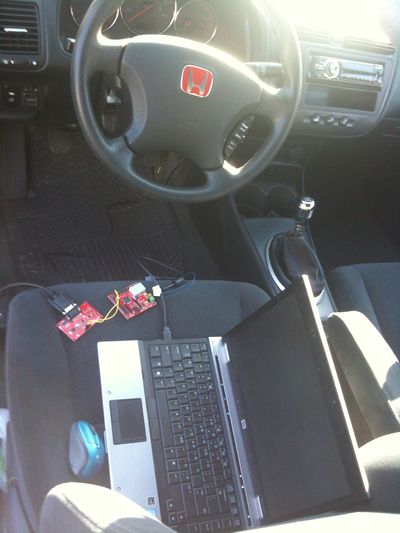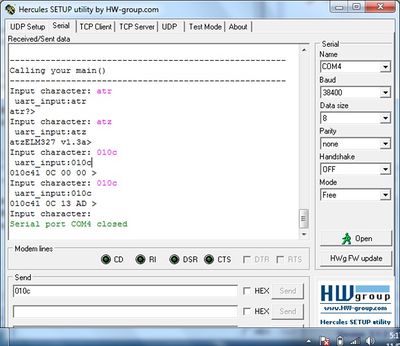F13: Vehicle On Board Diagnostics
Contents
Grading Criteria
- How well is Software & Hardware Design described?
- How well can this report be used to reproduce this project?
- Code Quality
- Overall Report Quality:
- Software Block Diagrams
- Hardware Block Diagrams
- Schematic Quality
- Quality of technical challenges and solutions adopted.
Vehicle On Board Diagnostics
Abstract
The goal of this project is to develop a monitoring system for an automobile utilizing the SJSU development board containing an ARM LPC1758 chip. The monitoring system shall obtain key parameters from the ECU of the vehicle, in this case a Honda Civic '05. These parameters shall be processed by the LPC1758 chip and distributed to the LCD screen and stored into the micro SD card. If time permitting, the monitoring system shall incorporate an interface to an mobile app.
This platform will provide a means of tracking car performance characteristics.
Objectives & Introduction
- Extract RPM and Speed data from vehicle
- Interface with vehicle through UART bus by means of the On Board Diagnostic OBDII connector
- Data sent to LCD and displayed to user using either UART, I2C, or SPI bus
- Data stored into micro SD card through SPI bus in a view able format for future processing on a PC.
Team Members & Responsibilities
- Jonathan
- Hardware and Software Designer
Schedule
Show a simple table or figures that show your scheduled as planned before you started working on the project. Then in another table column, write down the actual schedule so that readers can see the planned vs. actual goals. The point of the schedule is for readers to assess how to pace themselves if they are doing a similar project.
| Week# | Date | Task | Completed |
|---|---|---|---|
| 1 | 10/7 | Project Proposal | Y |
| 2 | 10/14 | Order Parts for Project | Y |
| 3 | 10/21 | Receive Parts and work on schedule | Y |
| 4 | 10/28 | UART to OBII communication, Setup UART H/W | Y |
| 5 | 11/4 | SPI interface with LCD display, Setup SPI H/W | |
| 6 | 11/11 | SPI to SD card interface | |
| 7 | 11/18 | Purchase enclosure, Perform integration and test | |
| 8 | 11/25 | Debug and Complete wikipedia report | |
| 9 | 12/2 | Prepare Presentation |
Parts List & Cost
Give a simple list of the cost of your project broken down by components. Do not write long stories here.
| Number | Description | Quantity | Price ($) |
|---|---|---|---|
| 1 | Car Diagnostic Kit, RTL-10769 | 1 | 59.95 |
| 2 | Male/Female Jumper Wires | 10 | 10.00 |
| 3 | Cell Phone Battery Charger | 1 | 20.95 |
| 4 | Micro SD Card 2 GB | 1 | 5.00 |
| 5 | LCD Display, NHD-0420D3Z-NSW-BBW-V3 | 1 | 25.90 |
| 6 | SJ One Board | 1 | 75.00 |
| 7 | Total | 182.25 |
Design & Implementation
The hardware design focuses on the SJ One board. This board communicates to the peripheral devices through UART, SPI, and I2C bus interfaces while powered by AA batteries. The three peripheral devices are a Honda Civic engine control unit (ECU), a LCD, and a micro SD card. Between the ECU and SJ One board is an intermediate board that translates UART commands into OBDII commands.
The software design emphasizes a polling methodology. A large loop initiated by the user constantly requests information from the ECU through UART drivers. The returned data is in ASCII and converted into integers for processing. Once processed, the information is sent to the LCD for display and micro SD for storage through the SPI interface. This cycle is repeated until a memory limit or user stops the process.
Below is the overall functional block diagram.
Hardware Design
The hardware design's center is the SJ One board. There are three communication interfaces and one power interface. The first communication interface, UART2, utilizes pins TXD2 and RXD2 on the SJ One board. A jumper wire from TXD2 goes to the RX-1 pin and RXD2 goes to the TX-0 pin of the UART-OBDII board. Finally, a ground jumper between the boards completes the UART interface. From the UART-OBDII board, an RS232 to OBDII cable completes the connection to the car's ECU.
The second communication interface, SPI, bus, utilizes pins SCK1, MISO1, and MOSI1 to connect to the LCD's corresponding pins. To power the LCD, two jumpers are applied, one for the 5V input and one for the ground to the LCD display.
The last communication interface is already hardwired on the SJ One board. A micro SD card slot holder is available on the back of the board. You only need to install the card.
Discuss your hardware design here. Show detailed schematics, and the interface here.
Hardware Interface
In this section, you can describe how your hardware communicates, such as which BUSes used. You can discuss your driver implementation here, such that the Software Design section is isolated to talk about high level workings rather than inner working of your project.
Software Design
The software constantly sends commands to the ECU for RPM, speed, then temperature sequentially. The commands should return values for RPM, speed, and temperature. The RPM, speed, and temperature must be converted into understandable numbers. Once translated, the data is passed to the LCD in a format for optimized display. It is also stored in a TBD format to the SD card.
Show your software design. For example, if you are designing an MP3 Player, show the tasks that you are using, and what they are doing at a high level. Do not show the details of the code. For example, do not show exact code, but you may show psuedocode and fragments of code. Keep in mind that you are showing DESIGN of your software, not the inner workings of it.
Implementation
This section includes implementation, but again, not the details, just the high level. For example, you can list the steps it takes to communicate over a sensor, or the steps needed to write a page of memory onto SPI Flash. You can include sub-sections for each of your component implementation.
Testing & Technical Challenges
Describe the challenges of your project. What advise would you give yourself or someone else if your project can be started from scratch again? Make a smooth transition to testing section and described what it took to test your project.
Test Phase 1 UART to OBDII communication Test
- Send individual commands to the car's ECU and receive RPM, temperature, and speed back
Include sub-sections that list out a problem and solution, such as:
My Issue #1
Initial Problem with UART to OBDII communication. The commands that were sent did not receive response. I noticed that the LEDs on the UART to OBDII board were flashing when they should not. I realized that I did not ground the board.
Conclusion
Conclude your project here. You can recap your testing and problems. You should address the "so what" part here to indicate what you ultimately learnt from this project. How has this project increased your knowledge?
Project Video
Upload a video of your project and post the link here.
Project Source Code
Send me your zipped source code and I will upload this to SourceForge and link it for you.
References
Acknowledgement
Any acknowledgement that you may wish to provide can be included here.
References Used
List any references used in project.
Appendix
You can list the references you used.
